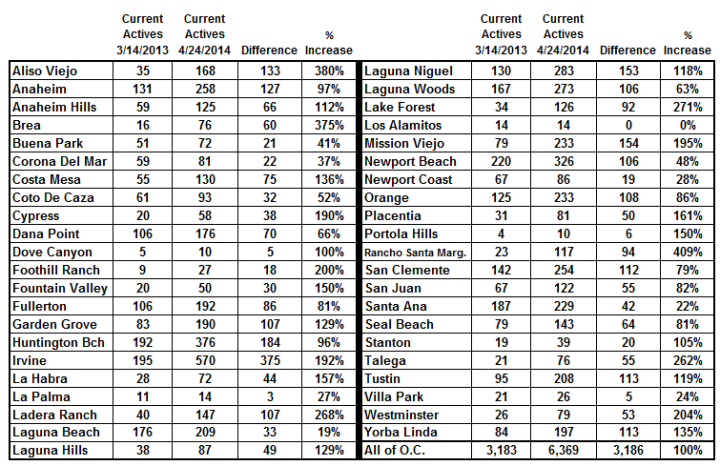Trulia: 10 most out-of-touch housing markets
 As the whispers of housing reform start to grow into greater fruition, the topic of conforming loan limits is brought up as well.
As the whispers of housing reform start to grow into greater fruition, the topic of conforming loan limits is brought up as well.
In his latest blog, Jed Kolko, chief economist with Trulia, noted that the current system of conforming loan limits falls far short of reflecting the actual differences in local home prices and ends up favoring borrowers in lower-cost markets.
“The housing finance system – as well as other national housing policies – needs to serve a country where local home prices in some markets are 10 times as high as in others, and where local and state laws affect how much new construction is allowed, how long foreclosures take, and more,” Kolko said.
In the current system, the conforming system sits at $417,000. However, in 2008, the Housing and Economic Recovery Act granted “high cost area” higher conforming loans limits to reflect local price differences.
But as housing regulators markup the Johnson-Crapo housing finance reform bill on Tuesday, April 29, 2014, Kolko pointed just how the conforming loan limits fall short.
Using Trulia’s database of homes for sale, Kolko listed the top 10 housing markets with the highest share of for-sale homes above the local loan limit, showing just how out of touch conforming loan limits are.
10. Boston, Mass.
Currently, $470,350 is the conforming loan limit, while 30% of homes for sale are above the local loan limit.
9. Oakland, Calif.
Right now 30% of homes for sale are above the local loan limit, with the conforming loan limit sitting at $625,500.
8. New York, N.Y.
The conforming loan limit sits at $625,500 for New York, with 30% of homes for sale above the local loan limit.
7. Middlesex County, Mass.
The city’s conforming loan limit weighs in at $470,350, with 33% of homes for sale above the local loan limit.
6. San Diego, Calif.
So far, the city’s conforming loan limit is $546,250, with 33% of the homes for sale above the local loan limit.
5. Ventura County, Calif.
The conforming loan limited is $598,000, with 34% of the homes for sale above the local loan limit.
4. Orange County, Calif.
Orange County has a conforming loan limit of $625,500, with 38% of the homes for sale above the local loan limit.
3. Fairfield County, Calif.
In Fairfield County, the conforming loan limit is $601,450, and 39% of homes for sale are above the local loan limit.
2. San Jose, Calif.
This city posted a $625,500 conforming loan limit, with 43% of the homes for sale above the local loan limit.
1. San Francisco, Calif.
San Francisco posted that its conforming loan limit sits at $625,500. With a whopping 61% of the homes for sale above the local loan limit, it is the nation’s most out-of-touch housing market.
Comments Off on Trulia: 10 most out-of-touch housing markets
What’s Ahead For Mortgage Rates This Week – April 28, 2014
 Last week’s economic news supported recent reports that home sales were fewer and home prices increased, but did so at a slower pace.
Last week’s economic news supported recent reports that home sales were fewer and home prices increased, but did so at a slower pace.
The NAR reported a slower pace of existing home sales, and FHFA reported a slower year-over-year rate of growth for home prices on properties financed by Fannie Mae and Freddie Mac.
The U.S. Commerce Department reported that new home sales fell to their lowest level since July 2013. Mortgage rates rose for fixed rate mortgages, but were unchanged for 5/1 adjustable rate mortgages. Here are the details:
Existing Home Sales Slow, Moderate Growth In Home Prices
March sales of existing homes dipped by 0.20 percent according to the NAR. 4.59 million previously owned homes were sold on a seasonally adjusted annual basis against projections of 4.55 million sales and February’s reading of 4.60 million pre-owned homes sold.
Rising home prices contributed to the slowdown in sales, which started last summer. Rapidly rising home prices due to short supplies of available homes and high demand for homes caused some buyers to leave the market. The national average price for existing homes was $198,500 in March, which represented a year-over-year increase of 7.90 percent.
The Federal Housing Finance Agency, which governs Fannie Mae and Freddie Mac, reported that home prices for homes financed with Fannie Mae and Freddie Mac owned mortgages rose by approximately 7.0 percent year-over-year as of February.
Severe winter weather was cited as a possible factor in slowing home sales, but as the peak home buying season gets underway, analysts forecast that some sales lost may be recovered in warmer weather.
Mortgage Rates Rise, New Home Sales At Lowest Level In 21 Months
Freddie Mac reported that average mortgage rates for fixed rate mortgages rose. The rate for a 30-year fixed rate mortgage rose by six basis points to 4.33 percent; the rate for a 15-year fixed rate mortgage also rose by six basis points to 3.39 percent.
The average rate for a 5/1 adjustable rate mortgage was unchanged at 3.03 percent. Discount points were also unchanged at 0.60,.60 and 0.50 percent respectively.
Sales of new single-family homes slumped to their lowest level in since July 2012 according to the U.S. Department of Commerce. The median price of a new single family home rose to $290,000, which represented a 12.60 percent increase year-over-year.
Analysts noted that month-to-month home sales numbers are not as reliable as sales trends measured over months, but 384,000 March sales of new homes fell markedly short of expectations of 450,000 new home sales and February’s upwardly revised reading of 440,000 new homes sold.
Unemployment Ups And Downs Contribute To Buyer Uncertainty
New jobless claims rose to 329,000 against expectations of 315,000 new jobless claims and the prior week’s reading of 305,000 new jobless claims. The Labor Department said that seasonal adjustments were incomplete due to the Easter holiday, which occurs on different dates.
As labor and other sectors of the economy endure ups and downs during the economic recovery, it is reasonable to expect some home buyers to put off buying homes.
This Week
This week’s scheduled economic news includes Pending Home Sales, Case-Shiller’s Housing Market Index, the FOMC meeting and statement and Construction Spending. The Bureau of Labor Statistics will release April’s Non-Farm Payrolls Report and National Unemployment Report on Friday.
Comments Off on What’s Ahead For Mortgage Rates This Week – April 28, 2014
It Frequently Pays Off To Refinance Your Mortgage
 To refinance a mortgage means to pay off your existing loan and replace it with a new one.
To refinance a mortgage means to pay off your existing loan and replace it with a new one.
There are many reasons why homeowners opt to refinance, from obtaining a lower interest rate, to shortening the term of the loan, to switching mortgage loan types, to tapping into home equity.
Each has its considerations.
Lower Your Mortgage Rate
Among the best reasons to refinance is to get access to lower mortgage rates. There is no “rule of thumb” that says how far rates should drop for a refinance to be sensible. Compare your closing costs to your monthly savings, and determine whether the math makes sense for your situation.
Shorten Your Loan Term
Refinancing your 30-year fixed rate mortgage to a 20-year fixed rate or a 15-year fixed rate is a sensible way to reduce your long-term mortgage costs, and to own your home sooner. As a bonus, with mortgage rates currently near all-time lows, an increase to your monthly payment from a shorter loan term may be negligible.
Convert ARM To Fixed Rate Mortgage
Homeowners with adjustable-rate mortgages may want the comfort of a fixed-rate payment. Mortgage rates for fixed-rate mortgages are often higher than for comparable ARMs so be prepared to pay more to your lender each month.
Access Equity For Projects, Debts, Or Other Reasons
Called a “cash out” refinance, homeowners can sometimes use home equity to retire debts, pay for renovations, or use for other purposes including education costs and retirement. Lenders place restrictions on loans of this type. A refinanced home loan can help you reach specific financial goals or just put extra cash in your pocket each month – just make sure that there’s a clear benefit to you.
Paying large closing costs for small monthly savings or negligible long-term benefit should be avoided. Many lenders offer low- or no-closing costs options for refinancing. Be sure to ask about it.
Don’t have a preferred lender? I have a few I can wholeheartedly recommend.
Comments Off on It Frequently Pays Off To Refinance Your Mortgage
What’s Ahead For Mortgage Rates This Week – April 21, 2014
 Last week’s economic news supported the general outlook for moderate economic growth. Housing related news included the National Association of Home Builders / Wells Fargo Housing Market Index for April and Housing Starts for March.
Last week’s economic news supported the general outlook for moderate economic growth. Housing related news included the National Association of Home Builders / Wells Fargo Housing Market Index for April and Housing Starts for March.
NAHB: Builder Confidence Holds Steady Amid Concerns
The NAHB/Wells Fargo HMI for April ticked upward by one point to a reading of 47 against the March revised reading of 46. Home builders surveyed expressed concerns about high home prices, a lack of available lots for development and a labor shortage. Some desirable markets have been held back due to low inventories of available and/or affordable homes.
Builders surveyed for the HMI were asked to rate three components used in compiling the monthly index; these include current market conditions, market conditions expected over the next six months, and buyer foot traffic in newly built homes. April’s readings were 51, 57 and 32 respectively.
Readings for current market conditions and buyer foot traffic were unchanged from March, but builder confidence for market conditions in the next six months rose by four points.
Any reading above 50 indicates that more builders are confident about market conditions for newly-built single-family homes than not.
Housing Starts Pick Up After Winter Storms, But Fall Short Of Expectations
March Housing Starts rose by 2.80 percent at a seasonally adjusted annual rate of 946,000 starts as compared to expectations of 990,000 and February’s reading of 920,000 housing starts, which was revised from 907,000 starts.
The March reading represented a 5.90 percent decrease from March 2013, and is consistent with concerns expressed by home builders surveyed for the NAHB HMI for April.
Building permits issued for March were also lower by 2.40 percent at a rate of 990,000 permits issued. This slippage was largely due to the falling rate of building permits issued for apartment construction.
Higher home prices and mortgage rates along with inconsistent (but improving) labor markets were cited as reasons for builder pessimism, but analysts said that projects delayed by severe weather are expected to pick up in the coming months.
Mortgage Rates Fall, Discount Points Hold Steady
Last week’s average mortgage rates fell across the board according to Freddie Mac’s weekly Primary Mortgage Market Survey. The rate for a 30-year fixed rate mortgage fell by seven basis points to 4.27 percent. 15-year mortgages had an average rate of 3.33 percent as compared to the prior week’s reading of 3.38 percent. 5/1 adjustable rate mortgages had an average rate of 3.03 percent, down from 3.09 percent the previous week. Discount points were unchanged at 0.70, 0.60 and 0.50 percent respectively.
Fed Chair Upbeat In New York Speech
Federal Reserve Chair Janet Yellen struck a positive note in a speech given before the Economic Club of New York last Wednesday. She indicated that the Fed and many economists expect a return to full employment and stable prices by the end of 2016. Analysts characterized Yellen’s speech as upbeat on economic recovery and inflation, while “dovish” on monetary policy.
Ms. Yellen reiterated the Fed’s intention to monitor current and developing economic situations before making changes to its current monetary policy. She acknowledged that “twists and turns” in the economy could occur, and that Fed policy would shift as needed to address changes.
The Fed also released its Beige Book Report last Wednesday. This report indicated that the economy is recovering in most areas of the U.S.
This Week
This week’s scheduled economic news includes Leading Economic Indicators, Existing Home Sales for March, FHFA House Price Report for February and New Home Sales for March. The University of Michigan Consumer Sentiment report for April rounds out this week’s news.
Comments Off on What’s Ahead For Mortgage Rates This Week – April 21, 2014











 Real estate investments are still going strong and will probably continue to be a popular method of financial gain into the future.
Real estate investments are still going strong and will probably continue to be a popular method of financial gain into the future.
Comments Off on Mortgage vs. Cash: Which Is the Better Option When Buying a Home?